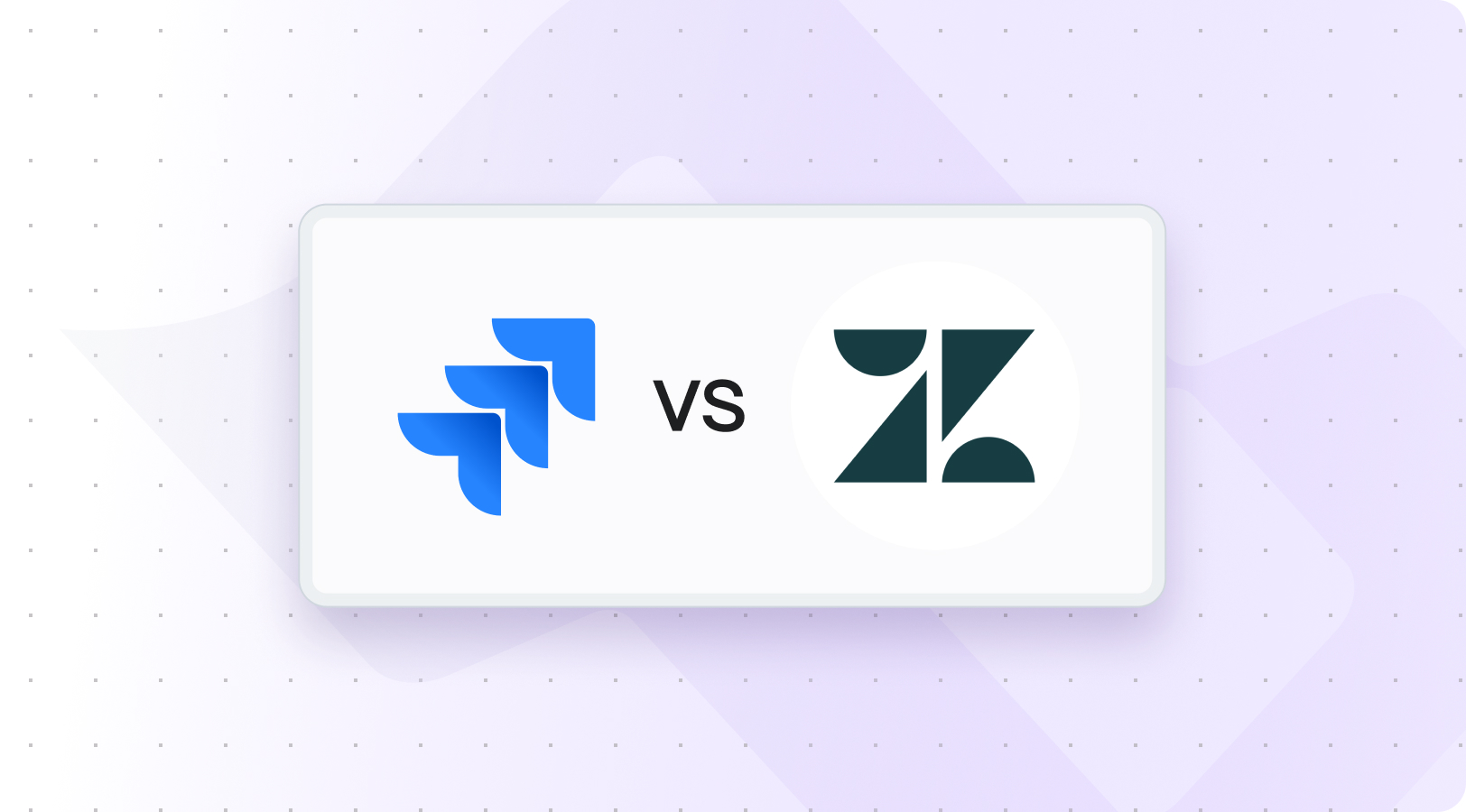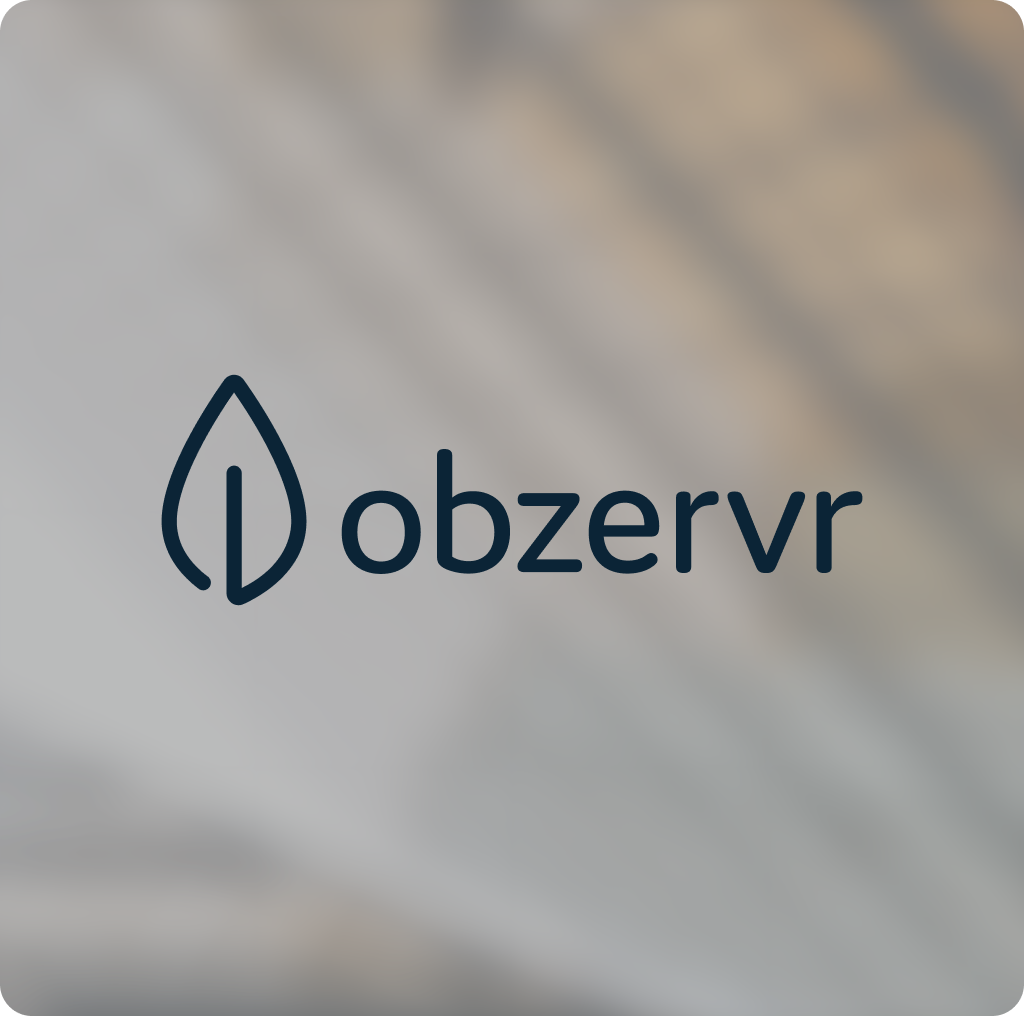Teams today work across dozens of service desk platforms, knowledge bases, ticket management, development tools, and internal processes. When customers or employees need help, they naturally expect a fast, consistent experience — no matter who handles ticketing system.
So today we will compare two platforms designed for different types of service management work:
- Jira Service Management (JSM) — Atlassian’s ITSM and internal service platform.
- Zendesk — a leading customer service tool for external support teams.
Both are strong and widely adopted. Both offer robust automation, reporting, and integration capabilities. But their foundations differ: Zendesk focuses on external customer interactions, while Jira Service Management supports internal ITSM operations, service delivery, and collaboration with development teams. Choosing the right tool starts with understanding these foundations.
This guide walks you through the practical distinctions — from request management to automation rules, from knowledge management to analytics, from ease of use to ecosystem fit — so you can choose the platform that matches the reality of your teams.
Jira vs Zendesk: Key Differences at a Glance
Different teams rely on Jira Service Management and Zendesk for different reasons, and those reasons become clear once you compare their key features side by side. At the highest level, the two platforms take distinct approaches to how service work should be organized, delivered, and supported. Looking at their main strengths helps clarify which direction aligns better with your needs before diving deeper into individual features.
Internal Support or External Customer Support?
The comparison highlights a clear pattern: Jira Service Management aligns with IT workflows, change processes, and collaboration with IT teams, while Zendesk is built around customer paths and multichannel communication. Many organizations already lean one way simply based on whether their primary focus is internal service supply or external support.
The next step is to understand each platform more deeply — what they offer, how they’re structured, where they fit in real-world scenarios, and how they can be customized.
What Is Jira Service Management?
Jira Service Management is Atlassian’s service management platform built for internal IT teams, and organizations that need structured ITSM capabilities. It expands on Jira’s project and issue management foundations, giving service desk teams tools to manage service requests, incidents, problems, changes, and assets in one system.

Its biggest strength is the alignment between development and support teams. Because JSM sits directly on top of Jira Software, IT teams, product teams, and service teams work inside a connected environment. Issues escalate smoothly, change workflows are traceable, and information moves without switching tools.
Key characteristics include:
- ITSM-ready workflows for requests, incidents, problems, and changes
- Native asset and configuration management through Jira Assets (CMDB)
- Automation rules designed for backend processes and DevOps alignment
- Tight integration with other Atlassian products and development tools
- Flexible request intake via email, portals, forms, or internal teams
- Advanced SLA management for internal and cross-team collaboration
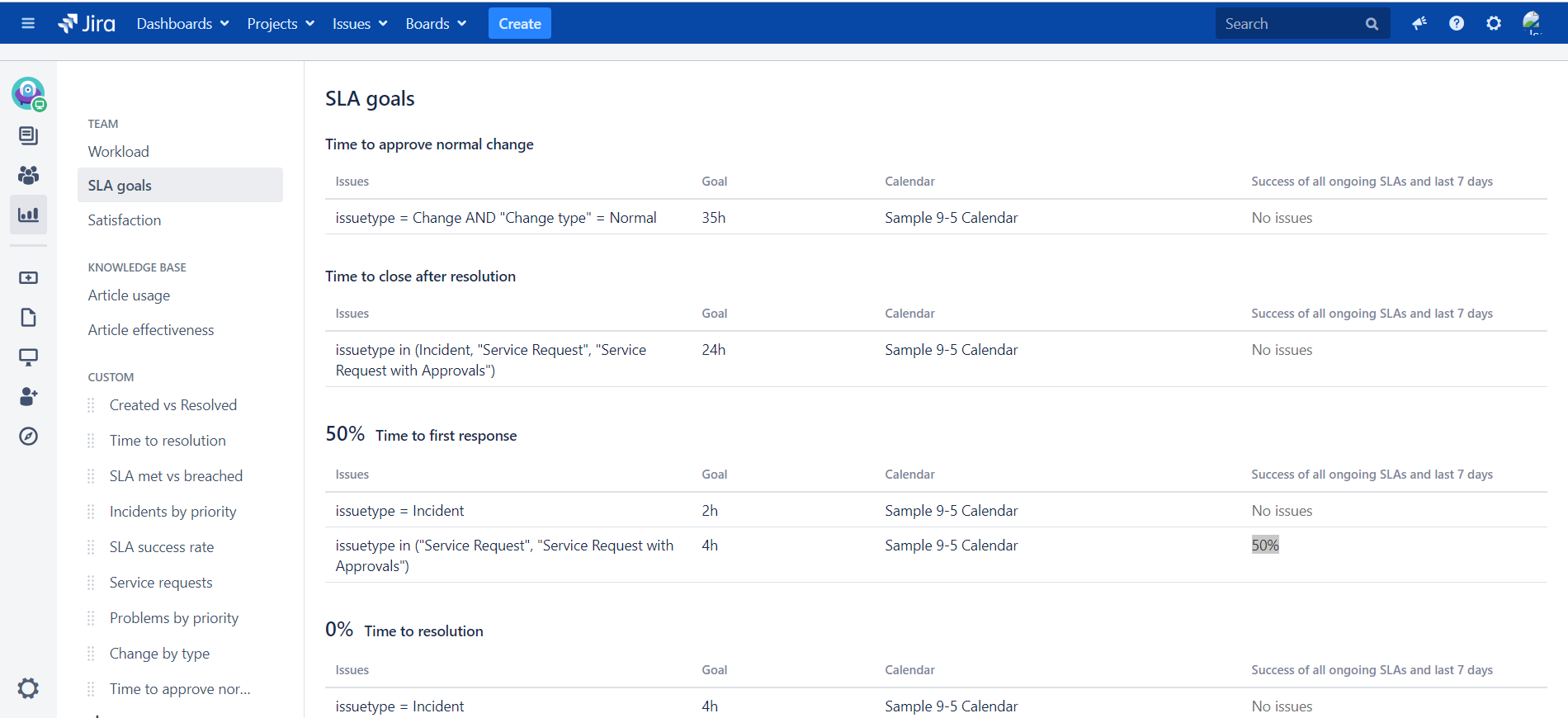
- Customizable dashboards that adapt to different departments and processes
Teams often choose Jira Service Management when:
- they need internal service supply, not external customer support
- IT, operations, and development teams must collaborate closely
- service processes rely on structured change and incident management
- asset & configuration management or CMDB is part of daily operations
- the organization is already working in Jira or other Atlassian tools
Overall, Jira Service Management is best suited for organizations where IT service desks operations, and development need to live in the same ecosystem — without losing flexibility or control.
What Is Zendesk?
Zendesk is a customer service platform designed for external teams that need to handle high volumes of customer inquiries across many channels. Its structure, interface, and automation features are optimized for fast, consistent, customer-facing communication.
Where Jira Service Management emphasizes IT workflows and internal processes, Zendesk focuses on customers. It’s built for teams that work with large, diverse audiences — whether through email, chat, social media, phone, or embedded widgets.
Core strengths include:
- Multichannel support across email, chat, social, voice, and messaging apps
- An intuitive, user-friendly interface designed for fast onboarding
- AI-assisted responses and agent productivity tools
- Strong ticket management and triage capabilities
- Built-in help center and self-service options
- Customer-focused reporting and analytics
- A large marketplace of third-party integrations
Teams choose Zendesk when:
- their primary role is external client support
- agents handle high volumes of repetitive questions
- multichannel communication is essential
- they need fast setup and user-friendly interface suitable for the users outside IT teams
- customer experience metrics — like CSAT, FRT, or omnichannel performance — guide decisions
Zendesk is fundamentally a customer support platform, not an ITSM solution. It shines in environments where speed, simplicity, and customer communication are top priorities.
Key Features: Detailed Comparison
Once you understand the general differences between Jira Service Management and Zendesk and took a glance at our introductory table of Zendesk and Jira features, it becomes easier to compare in details how they handle actual service work.
Below, we break down the areas that most teams evaluate when deciding between the two platforms — from how they manage employees and customer requests to how they support automation, knowledge management, some advanced features, analytics, and day-to-day operations.
Ticketing System and Request Management
Both tools revolve around managing incoming requests, but the way they approach this looks very different.
Jira Service Management treats requests as part of broader service processes. A ticket is not just a conversation — it’s often tied to an internal system, a change workflow, or collaboration with dev teams. This makes JSM strong for structured service requests, incidents, problems, and changes. Each request can follow a customized workflow, with clear transitions, approvals, and routing logic.
Zendesk focuses on the communication side. Tickets flow quickly, agents get the context they need, and interactions stay neatly organized. It doesn’t expect a ticket to trigger a deployment, approval chain, or incident workflow — it’s built for customer conversations first. This makes the system fast, efficient, and easy to use for customer-facing teams.
If your requests are tightly connected to internal processes, JSM aligns better. If your requests are large in volume and require fast triage, Zendesk takes the lead.
Incident, Problem, and Change Management Features
This is one of the clearest areas where the tools diverge. Jira Service Management includes native ITSM practices:
- incident workflows,
- problem investigation,
- root cause analysis,
- change management with risk assessments,
- approvals,
- post-incident reviews.
For IT teams or organizations with compliance requirements, this structure is essential.
Zendesk supports basic incident documentation, but it doesn’t offer the deeper ITSM processes needed for technical environments. Teams can approximate workflows with apps or custom routing, but it isn’t built for formal change control or internal risk management.
For organizations that rely on ITIL-style operations, JSM is the natural choice.
Multichannel Support and Customer Experience
Zendesk is the clear leader here — and intentionally so. The platform is built for communication across:
- email,
- chat,
- social media,
- SMS,
- voice,
- messaging apps.
Agents can switch channels without losing context, and customers can reach support through whichever medium they prefer.
Jira Service Management focuses mainly on internal communication. It supports email and portal-based request submission, which is ideal for employees or internal users but not designed for external multichannel interactions.
If you need customer support solution — Zendesk’s multichannel experience is unmatched.
Knowledge Base and Self-Service
Both platforms handle knowledge base management, but with different priorities.
Jira Service Management integrates deeply with Confluence. For organizations that already use Confluence as their internal knowledge base or documentation hub, this creates a strong, well-organized self-service ecosystem. Articles can be structured, versioned, linked to issues, and used across internal workflows.

Zendesk’s help center is simpler, faster, and more intuitive for external audiences. It’s designed so customers can find quick answers without navigating complex documentation. AI assistance can surface relevant articles automatically based on the customer’s question.
JSM is better for internal documentation and structured knowledge work; Zendesk is better for external audiences who need quick answers.
User Interface and Ease of Use
Zendesk is known for having a clean, intuitive user interface that helps teams get up to speed quickly. It’s designed for non-technical users, and most agents can navigate the system with little or no training. For customer-facing teams that need an easy to use interface, this simplicity is a major advantage.
Jira Service Management offers more depth, but the interface reflects its flexibility. Teams familiar with Jira will find it consistent, while new users — especially those outside technical roles — may need more time to adjust. The learning curve is higher, but it comes with greater control over workflows and processes.
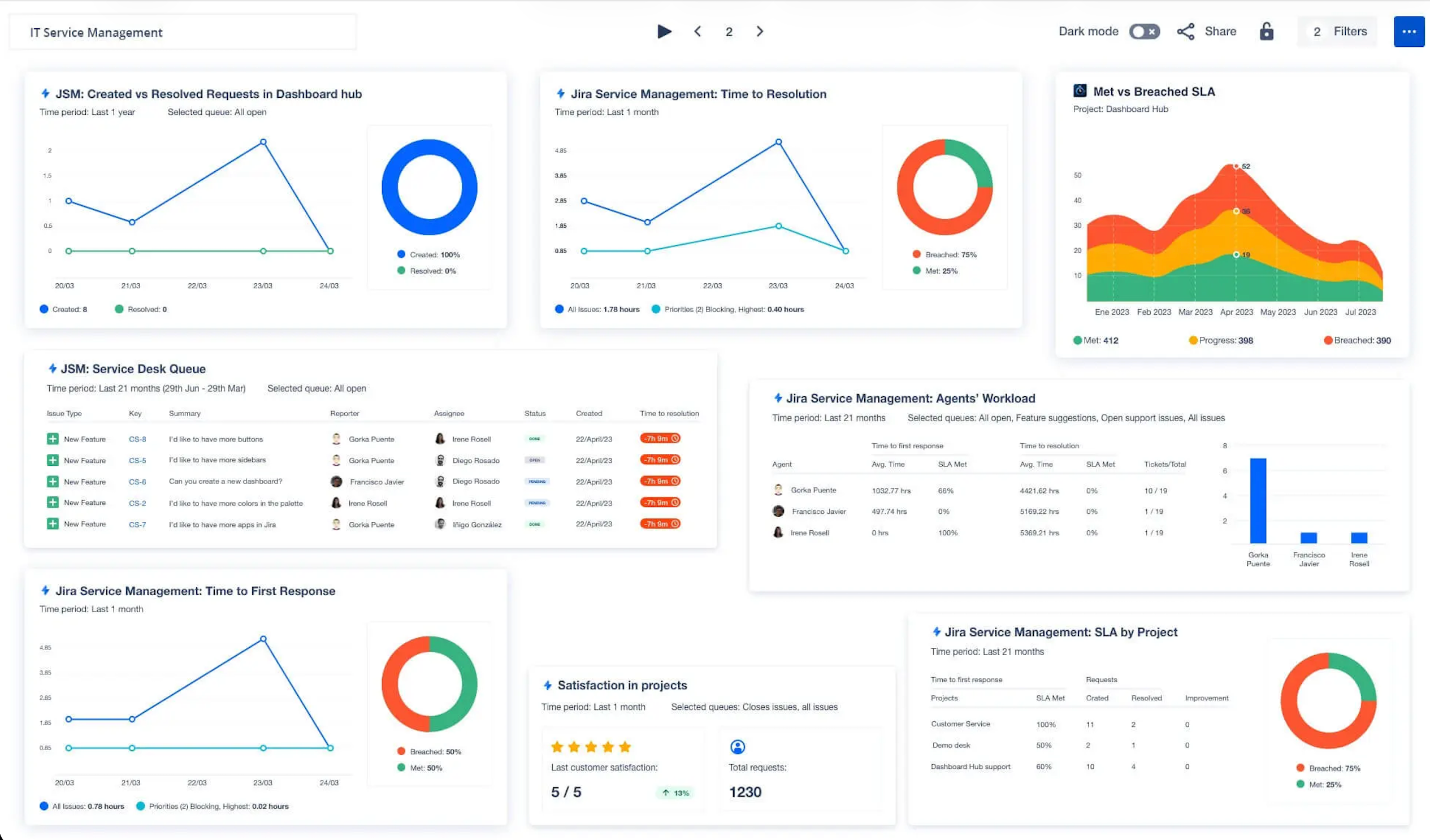
Automation and AI
Jira Service Management’s automation is strongest on the backend. Rules can update fields, trigger workflows, integrate with development processes, or execute complex logic tied to SLAs, changes, and incidents. It aligns naturally with DevOps-connected work.
Zendesk’s automation focuses on agent efficiency. Macros, bots, and AI-generated response suggestions speed up customer communication. The platform reduces manual work during high-volume ticket periods and helps keep responses consistent across teams.
In short:
- JSM excels at automating service operations.
- Zendesk excels at automating customer interactions.
Reporting Tools, Dashboards, and Analytics
Zendesk provides detailed analytics tailored to customer support metrics — ticket volume, agent performance, CSAT scores, response times across channels, customer sentiment, and more. It fits well in organizations where customer data metrics drive decisions.
Jira Service Management takes a different approach. It offers operational dashboards, SLA tracking, and insight into service workflow performance. For teams that manage incidents, changes, and internal requests, these operational insights matter more than CSAT dashboards.

Zendesk wins in customer reports; JSM wins in internal delivery analytics.
Integration Capabilities
Jira Service Management offers a native support for integrating with Jira Software and other Atlassian products — making it good for teams where service work intersects with development. Integrations with CI/CD tools, monitoring platforms, and on-prem systems are common.
Zendesk integrates broadly across customer support systems — CRMs, communication tools, feedback platforms, ecommerce systems, and more. It’s optimized for external-facing workflows.
Both platforms also integrate with third-party tools like Getint, an integration platform on which we elaborate further in the text.
Management of Assets and Configuration Items (CIs)
This is another area where JSM stands out. Jira Assets (formerly Insight) is a full CMDB built into the platform. It helps teams manage hardware, software, configurations, dependencies, and relationships — which is essential for IT operations and compliance-heavy environments.
Zendesk doesn’t include this option natively. Teams can add apps from the marketplace, but the experience is not as integrated or robust.
If asset tracking is part of your service management, JSM offers a clear advantage.
SLA Management
Both tools support SLA tracking, but the use cases differ.
Jira Service Management treats SLAs as part of internal service workflows. They can trigger automations, escalate issues, or integrate with incident and change processes. Zendesk uses SLAs mainly for customer support response times and agent performance. The difference reflects their core audiences.
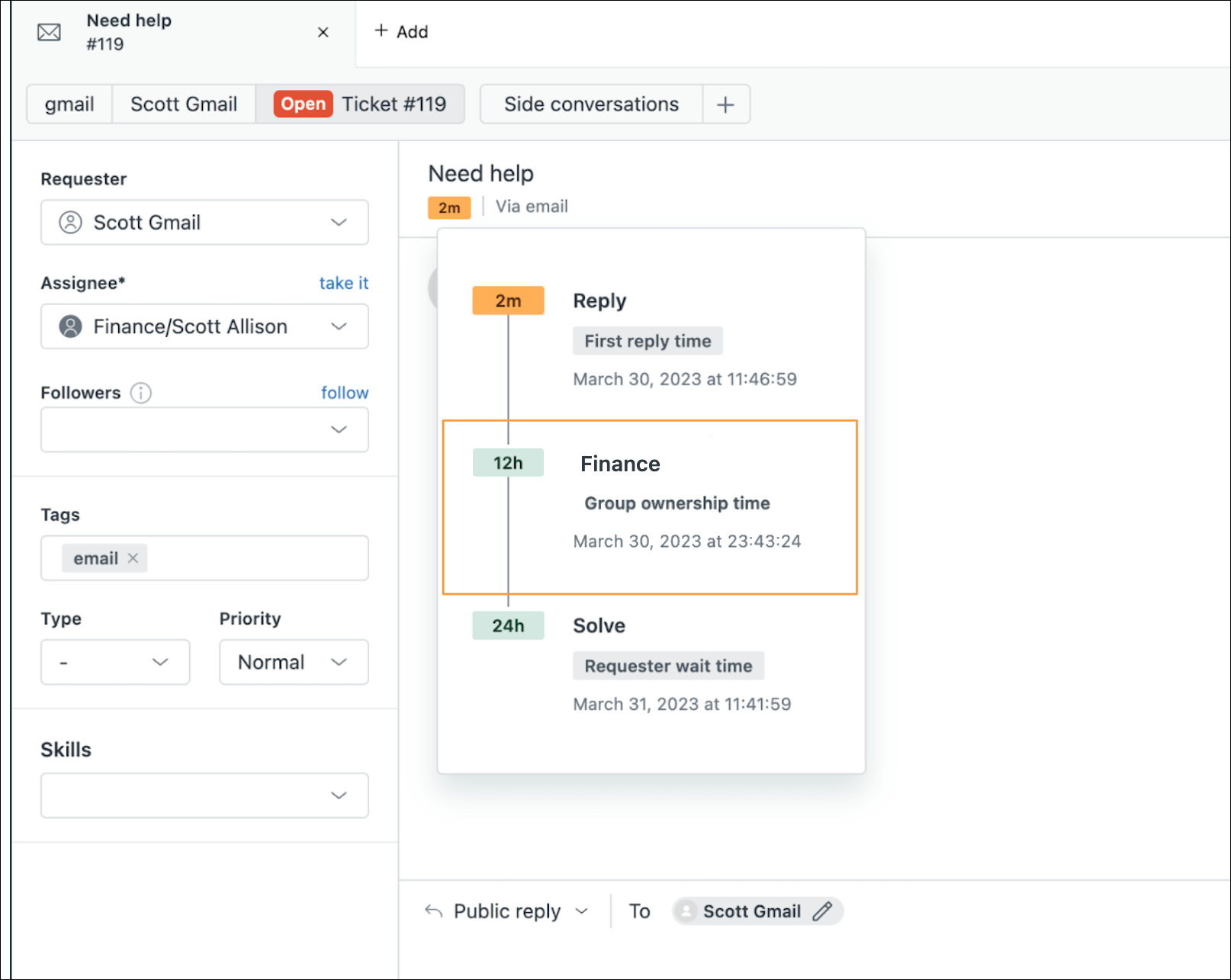
Ease of Use
Zendesk prioritizes simplicity. The interface is clean, intuitive, and easy to adopt for non-technical users. Customer support teams can get up to speed quickly without navigating complex workflows.
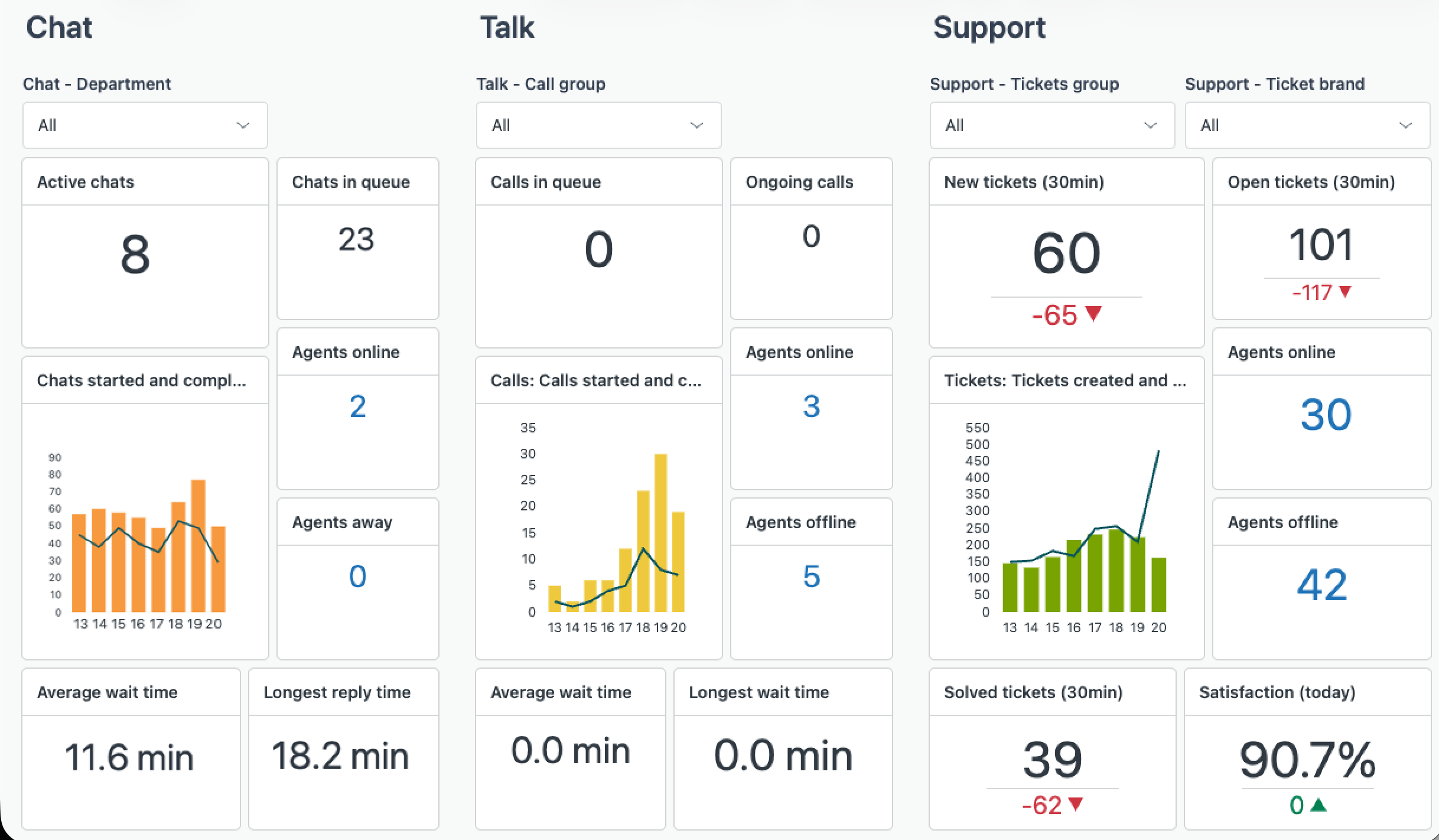
The learning curve is steeper in JSM. Teams get more flexibility and control, but they need to invest in customizable dashboards setup and configuration.
Organizations comfortable with Atlassian tools tend to adapt faster; others may need more onboarding time, especially when working with more complex projects.
Pricing Comparison
Pricing often becomes a deciding factor, not only because of monthly costs but because each platform scales differently as teams grow. Zendesk and Jira take distinct approaches that reflect their primary use cases — internal service supply versus external customer support.
Jira Service Management Pricing
Jira Service Management supports plans with flexible pricing model that works for teams of different sizes, starting with a free option for up to three agents. The free tier is limited to basic request management, but it gives smaller teams an easy way to explore the platform before committing.

Paid plans unlock more advanced features, including incident, problem, and change management, stronger automation rules, asset management, and additional customization options. Pricing increases as more agents are added, which aligns well with how internal service teams typically scale — gradually and across multiple departments.
Organizations already using Jira Software or Confluence often find it cost-effective to extend into JSM, since the tools share the same ecosystem and reduce the overhead of managing multiple platforms.
Zendesk Pricing
Zendesk does not offer free option. Teams begin on a paid tier after the trial period, with pricing varying depending on the depth of customer support features they need. Entry-level plans cover basic email support, while higher tiers introduce live chat, voice channels, AI-powered tools, workforce management, and advanced analytics.

Higher tiers unlock capabilities that customer support teams often rely on as they scale, such as workforce management, more robust reporting, and additional AI-driven tools for agent productivity. Because Zendesk is designed for environments where large volumes of support requests are common, its pricing model scales smoothly for fast-growing support operations.
For companies running customer experience operations or managing multiple support channels, Zendesk’s pricing often aligns better with the nature of that work. Organizations that rely heavily on the real-time agent experience — chat queues, macros, bots, or voice support — usually find the higher-tier plans justify the investment.
Choosing a Pricing Model That Fits Your Team
The biggest difference between the two platforms is what you’re paying to scale:
- Jira Service Management scales for internal service delivery, expanding as more teams adopt structured workflows, SLAs, or ITSM processes.
- Zendesk scales for customer-facing communication, adding value through additional channels, agent productivity tools, and customer experience analytics.
Teams looking for a no-risk first step may start with JSM’s free plan, while those planning large customer support operations will likely find Zendesk’s paid tiers better aligned with their needs.
Zendesk vs Jira: Pros and Cons
Every service platform makes deliberate trade-offs in the areas it prioritizes. Zendesk and Jira are no different. Below is a straightforward look at the strengths and limitations of each tool to help you understand where they naturally fit — and where they may require additional configuration or integrations.
Jira Service Management Pros
- Strong ITSM capabilities out of the box
Incident, problem, and change control come natively and fit teams with structured internal processes. - Deep alignment with development teams
Built on Jira Software, making escalations and cross-team collaboration easier. - Highly customizable workflows
Flexible automation, custom fields, SLAs, and routing logic support complex internal environments. - Asset and configuration management for high-velocity ITSM
Jira Assets provides visibility into hardware, software, and configuration relationships. - Good fit for cross-department internal service desks
IT, HR, Finance, Facilities, and other internal teams can run separate portals in one system.
Jira Service Management Cons
- Steeper learning curve for non-technical teams
The flexibility comes at the cost of a more complex setup. - Not ideal for customer support at scale
Limited native multichannel options compared to platforms designed for customer-facing communication. - Requires more configuration upfront
Teams often invest time in designing workflows, request types, and automation.
Zendesk Pros
- Excellent for external client support
Optimized for handling large volumes of customer inquiries quickly and consistently. - Intuitive and easy to onboard
Non-technical users can adopt the system with minimal training. - Strong multichannel capabilities
Email, chat, voice, messaging apps, and social channels are supported natively. - AI and automation built for agents
Response suggestions, bots, and macros improve speed and reduce repetitive work. - Clear and powerful customer experience reporting
CSAT, agent performance, channel analytics, and customer sentiment are easy to monitor.
Zendesk Cons
- Limited ITSM capabilities
No native change processing or CMDB; not designed for structured internal workflows. - Can become expensive at higher tiers
Advanced CX features and full omnichannel support may require premium plans. - Less connected to development ecosystems
Collaboration with engineering teams requires integrations or additional tooling.
Jira Service Management vs Zendesk: When Each Tool Makes Sense
Choosing between Jira Service Management and Zendesk is less about picking a “better” platform and more about understanding the type of service work your teams handle every day. Both Zendesk and Jira excel, but in different environments — and those differences become clear once you break down the real-world scenarios.
When Jira Service Management Fits Better
Jira Service Management is built for teams working inside the organization. IT, operations, HR, and other internal departments often follow structured processes: they manage service requests, approvals, incidents, changes, and dependencies that impact internal systems. For this kind of work, JSM feels natural from the start.
Because it sits on top of Jira Software, collaboration with development and tech teams is seamless. When a service request needs engineering involvement or an incident requires a code change, everything stays inside the same ecosystem. There’s shared context, shared visibility, and no need to push information across disconnected systems.
JSM also supports teams that rely on governance and predictability. Change enablement, problem management, asset tracking, and SLA enforcement are part of daily operations for many organizations — and these capabilities come built in.
Teams tend to choose JSM when their work revolves around internal operations, cross-team collaboration, or more structured ITSM-style processes.
When Zendesk Fits Better
Zendesk is shaped around external communication. It’s designed for customer support teams who manage fast, high-volume interactions across multiple channels: email, chat, social, voice, and messaging apps. The experience focuses on agent clarity and speed — everything in the interface is optimized to help support teams respond quickly and consistently.
Onboarding is extremely simple. Non-technical teams can start working productively almost immediately, without needing deep configuration or training. Automation supports the agent workflow: macros, bots, and AI suggestions help streamline repetitive tasks and high-volume ticket flows.
Businesses choose Zendesk when their priority is customer-facing support, where clarity, convenience, and omnichannel communication matter more than complex internal workflows.
When Both Tools Make Sense
Some organizations support both customers and employees — and their service work doesn’t fit neatly into one system.
A typical setup looks like this:
- Zendesk for customer-facing support and multichannel communication
- Jira Service Management for internal service operations and development-connected workflows
When these two sides of the organization work together — for example, when customer issues require technical investigation — Zendesk Jira integration becomes crucial. Let's take a look at how to connect both platforms using no-code platform without losing context between customer support professionals and IT teams.

Integrating Jira and Zendesk with Getint
When customer-facing teams work in Zendesk and technical or internal teams operate in Jira Service Management, information often needs to move between the two systems. Customer issues can evolve into technical investigations, incidents may require engineering input, and business teams may need full visibility into what originated in the support queue. Without a proper Zendesk integration, this handoff relies on manual updates, duplicated tickets, or communication gaps that slow teams down.
Third-party applications like Getint allows organizations to synchronize two platforms so each team can stay in the environment that supports their work best — without losing context.
A typical integration ensures that key information is shared automatically:
- Customer-facing agents in Zendesk can escalate issues to Jira Service Management without switching tools.
- Development or IT teams in Jira receive structured requests with the details they need to investigate, prioritize, or resolve the underlying problem.
- Updates flow both ways, keeping agents informed so they can communicate clearly with customers.
- Comments, status changes, and fields stay aligned across systems, reducing manual work and eliminating conflicting information.
- Each team maintains its own workflows, SLAs, and reporting structures while still collaborating effectively in one, comprehensive system.
Organizations adopt this approach when they want the strengths of both systems — Zendesk’s multichannel help experience and JSM’s operational depth — without forcing everyone onto a single platform. Integration creates a shared view of the work while respecting the different needs of support agents, IT teams, and engineering stakeholders.
By connecting the two environments, teams reduce delays, avoid miscommunication, and maintain a consistent experience for both customers and employees — regardless of where the work begins.
Migrating from Zendesk to Jira Service Management
While some organizations benefit from running Zendesk and Jira Service Management side by side, others eventually decide they need to move data from one platform to another. In those cases, a clean, reliable migration becomes just as important as day-to-day integration. When teams choose to move fully from Zendesk to JSM — for example, to unify internal and external support, simplify operations, or standardize on the Atlassian ecosystem — Getint helps them transition without losing historical data or breaking workflows.
A real example of this is the Obzervr case, where the team migrated thousands of Zendesk tickets into Jira Service Management using Getint. Instead of manually exporting and importing data — a process that often results in missing comments, broken attachments, or inconsistent fields — the data migration kept everything intact: ticket history, conversations, attachments, reporters, and custom fields. The team even created a dedicated JSM project for archived tickets, keeping legacy data accessible while keeping their new service desk clean and easy to manage.
For companies moving away from Zendesk or consolidating support into Jira Service Management, Getint provides a structured, repeatable migration path that preserves context and reduces operational disruption. It’s a practical way to simplify your tooling without sacrificing the records your teams rely on.
Conclusion
Both Zendesk and Jira Service Management are strong platforms — just built for different types of service work. Zendesk excels when teams support customers across multiple channels and need fast, agent-friendly tools. Jira Service Management is the better fit for internal service operations, structured ITSM processes, and environments where service work often intersects with development.
For many organizations, the choice Zendesk vs Jira, is obvious once they consider whether their primary audience is employees or customers. But when both groups need support — or when customer issues frequently require IT teams investigation — the two systems can complement each other well. Integrating them helps teams work in the tools that suit their workflows while still sharing the information needed to resolve issues quickly and consistently.
The right approach ultimately depends on your service model, your teams, and the complexity of your operations. Understanding how each platform supports different types of work is the key to choosing — and combining — the solutions that best fit your organization.

